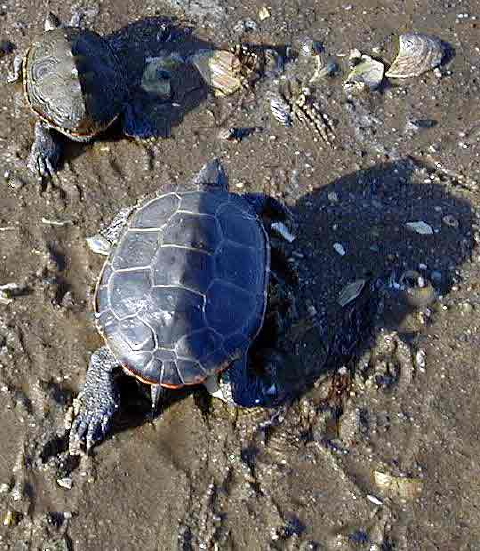Don’t let anybody fool you. In a good research program, you still have to score a string of goose eggs (documenting negative occurrences) unless you’d rather depend on Karnak-like intuition to tell you what’s inside the sealed envelope. So, conditions of a pre-dawn low tide in 45 degree temperature and northeast winds at 15 to 20 knots suggest that terrapins would prefer to burrow under a warm layer of ooze rather than be flushed out of their safe and comfortable marsh habitat. But there’s only one way to confirm this suggestion — and not many volunteers to do so.
Full Moon Illuminates Pre-Dawn Low Tide
I arrived on Lieutenant Island a little before 0430. A nearly full moon hovered over Great Island in the west, while a dull rosy glow, about the strength of a 2.5 watt nightlight, simmered in the east. The creek was cloaked in textured darkness, layers of ripples hinting at what lay beneath. In chest-high waders I plunged across the channel. Mating horseshoe crabs dotted the rapids like rocks on a Maine shore. But terrapins? None — no heads snorkeling for air, no shells rippling the current, no turtles paddling through the rip.
Sunrise over Old Wharf Point
So, all for naught? Hardly. First, there was solid confirmation of my working hypothesis, namely: Terrapins are a lot smarter than terrapin researchers. Secondly, as the moon set over Cape Cod Bay, a chorus of coyotes howled it down, echoing refrains from a pack somewhere south of Lieutenant Island to another high on the bluff of Old Wharf Point. Then, moonset was quickly followed by a dazzling sunrise over Blackfish Creek.
And, to punctuate a morning well spent, I caught sight of my first daylight meteor. It flashed over Indian Neck, an intense white tail trailing a bead of sparklers, whooshing silently across the northern sky and disappearing behind Griffin Island and The Gut. All this and I still reached the donut shop two minutes before it opened and one minute before the Wellfleet Police patrol car.
Coyote in Salt Marsh of Old Wharf Peninsula
As the mutts and I jeeped over to check the Old Wharf marsh at high tide, we had a surprise encounter with a pair of coyotes. This morning at dawn, I had heard howling from Old Wharf Point from what sounded like a pair and their offspring. The behavior of these coyotes seemed to confirm the presence of a nearby den.
When we reached the turn-off to the town landing, we spotted a coyote patrolling the marsh wrack line. Since I did not have a telephoto lens handy, all images represent actual distances. Motor still running, I reached for my camera and unzipped the driver’s window . . . fully expecting her to dash for cover.
Female Coyote Marks Her Territory
Instead, she turned and approached the jeep, cutting the distance by about a half, then squatted to mark scent midway between us and the background hill.
Coyote’s Mate Approaches from Southwest
As she sprayed, her mate approached from the southwest and both remained alert, keeping themselves between the jeep and the hill. They held their ground until we drove off toward Old Wharf Point, after which they slowly zigzagged into the cover of the background hill.
Now I’m a cold-hearted reptilian type and know little about these warm-blooded critters. But this behavior seemed in contrast to other encounters I’ve had with coyotes on the Cape. Not only did I have the jeep’s motor running, but she watched me as I frantically searched my backpack for my camera, hurriedly and noisily unzipped the window, pointed the camera in her direction, and tracked her movements with electronic shutter beeps. She should have spooked. If I did know more about coyotes, I might suspect that this undeveloped hill sheltered a den of whelps.
Fishing for Schoolie Stripers in Blackfish Creek
By the evening low, conditions had plunged back into bone-numbing range. Air temperature nudged 44 degrees at 1700 and kept falling to 39 by tide’s end. Water in the tidal flats had dropped back to 58°F. A stiff 25-knot breeze from the east northeast kicked up murky visibility and drove wind chills into a very unpleasant range. I’ll let you do the math.
| Â |
Still, weekend warriors from the urban mainland couldn’t be discouraged from casting a final lure at schools of stripers which have migrated back into Blackfish Creek for spring fattening.
Male Terrapin #680 Followed by Female Terrapin #663
And nothing short of ice floes scrubs the terrapin patrol. Conditions had deteriorated so badly with this incessant blow that nothing, not even horseshoe crabs, were visible on the rip. But as tide reached maximum ebb, I netted two terrapins by blind luck more than skilled turtling. The first (#680) is a mature male of 12.4 centimeters length and almost 300 grams. He was last spotted on 8 June 2000. Since then he gained 6.5% body mass while growing less than .1 centimeter all around. The second turtle (#663) is a mature female of 18.75 centimeters length and 1124 grams. She had last been observed on 4 June 2000 with nearly identical measurements. Besides her inpidual ID marking, Terrapin 663 is rather easy to spot with an enlarged, elongated 4th vertebral and a tiny rear vertebral.






